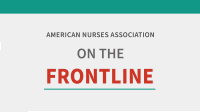Nurse advocacy could turn the tide on slow federal efforts.
The COVID-19 pandemic exposed several gaps in our healthcare system, including the ongoing challenge of nurse safety and workplace violence (WPV). Organizations that tracked data identified that incivility, bullying, and WPV had been increasing, but the pandemic exacerbated the intensity of these issues. Evidence-based interventions previously thought successful proved woefully lacking in the heat of racial tensions and the pandemic.
According to the Healthy Nurse, Healthy Nation™ (HNHN) 5-year report, 63% of nurses who responded to the HealthyNurse Survey indicated that they were at significant risk for workplace violence (tinyurl.com/ytz32vvp). The HNHN 2020–2021 report indicates that before and during COVID-19, nearly one-third of respondents experienced verbal and non-verbal aggression from a peer, 25% experienced verbal and non-verbal aggression from a person of authority, and 14% reported assaults from a patient or family member. Similarly, data from the 2022 Workplace Survey in the American Nurses Foundation Pulse on the Nation’s Nurses Survey Series indicate that since the pandemic, nurses’ experience of verbal abuse from patients or family members has increased (53%) (tinyurl.com/bdhzj6d6). Perhaps the most telling statistic comes from Press Ganey’s 2021 survey of nursing facilities, which found that two nurses per hour are assaulted in acute care settings.
How can nurses feel safe at work and protect themselves from verbal, non-verbal, and physical abuse? All workplaces should support and protect them by developing and implementing sound policies and procedures. However, we need federal policymakers to take the lead to ensure that employers implement substantive actions to improve worker safety.
Slow federal progress
Some states have passed WPV prevention laws, but no such federal law protecting nurses exists. The Occupational Safety and Health Administration (OSHA), tasked with developing a WPV prevention regulation, has researched the issue for decades and previously released voluntary guidance for employers to create prevention programs. As rates of WPV in healthcare keep rising, the need for national, mandatory regulation is clear.
OSHA began its rulemaking process in March 2023 by gathering feedback from a Small Business Advocacy Review (SBAR) in which small business employers considered a draft of the regulation and gave their observations. Next, OSHA will release a proposed rule for full public assessment, but when is unclear. Any member of the public will be able to submit comments via a letter to the agency. Nurses have the lived experience OSHA needs to hear, and the American Nurses Association (ANA) encourages all nurses to share their first-hand knowledge with the agency once the proposed rule comes out. Stay informed about and submit comments on this issue via federalregister.gov.
OSHA’s rulemaking process—driven by research and aimed at finding the best evidence-based solutions—can take many years. Yet nurses can’t wait for this life-saving rule. That’s why ANA supports passage of the Workplace Violence Prevention for Health Care and Social Service Workers Act (H.R. 2663/S. 1176). This bill would require OSHA to release an interim final WPV prevention rule within 1 year and a final standard within 3.5 years. OSHA has already conducted research, including its recent evidence gathering from SBAR. ANA encourages nurses to contact their legislators to ensure they cosponsor this bill. Visit RNAction.org to advocate for this bill and learn more about ANA’s policy priorities.
Emily Champlin is a senior policy advisor in ANA’s Policy and Government Affairs Department. Ruth Francis is a senior policy advisor in ANA’s Nursing Practice and Work Environment Department.
American Nurse Journal. 2023; 18(9). Doi: 10.51256/ANJ092386
References
American Nurses Association. Practice & Policy. nursingworld.org/practice-policy/work-environment/end-nurse-abuse
H.R.2663 – Workplace Violence Prevention for Health Care and Social Service Workers Act. 118th Congress (2023-2024). congress.gov/bill/118th-congress/house-bill/2663
Occupational Safety and Health Administration. Guidelines for Preventing Workplace Violence for Healthcare and Social Service Workers. 2016. osha.gov/sites/default/files/publications/osha3148.pdf
Occupational Safety and Health Administration. Workplace violence SBREFA. May 1, 2023. osha.gov/workplace-violence/sbrefa
Press Ganey. On average, two nurses are assaulted every hour, new Press Ganey analysis finds. September 8, 2022. pressganey.com/news/on-average-two-nurses-are-assaulted-every-hour-new-press-ganey-analysis-finds/




















